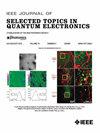散斑对比光学层析成像图像重建方法的线性验证
IF 5.1
2区 工程技术
Q1 ENGINEERING, ELECTRICAL & ELECTRONIC
IEEE Journal of Selected Topics in Quantum Electronics
Pub Date : 2025-06-19
DOI:10.1109/JSTQE.2025.3581407
引用次数: 0
摘要
散斑对比光谱学(SCOS)是一种能够无创测量人脑血流量和脑功能的光学技术。它的层析扩展,散斑对比光学断层扫描(SCOT),可以提供血流量变化图与测量使用重叠的源检测器通道对。大多数图像重建方法通常假设线性,但测量信号与血流变化之间的关系可能存在非线性。我们使用Rytov近似来求解相关扩散方程,构建了SCOT的正演模型,并将其与第一个Born近似以及更精确但计算成本较高的Monte Carlo模拟方法进行了比较。我们已经表明,使用Rytov近似获得的结果与蒙特卡罗模拟很好地一致,而第一个Born近似偏离了其他两种方法的大血流变化。例如,第一个Born近似在大约30%的脑血流量(CBF)变化在体积大小为$60\ × 50 \ × 40$ $ {mm}^{3}$ $时就会崩溃,因此我们建议在这个阈值以上使用Rytov近似。我们已经证明,我们在SCOT中测量的血流指数(BFi)与局部CBF变化呈线性关系,因此可以使用灵敏度矩阵方法线性解决正向和逆问题。然后,我们通过实验展示了使用我们最近开发的高密度SCOS系统显示人类大脑激活的图像重建。该方法对SCOT实验系统设计和数据分析具有指导意义。本文章由计算机程序翻译,如有差异,请以英文原文为准。
Validation of the Linearity in Image Reconstruction Methods for Speckle Contrast Optical Tomography
Speckle contrast optical spectroscopy (SCOS) is an optical technique capable of measuring human cerebral blood flow and brain function non-invasively. Its tomographic extension, speckle contrast optical tomography (SCOT), can provide blood flow variation maps with measurements using overlapping source-detector channel pairs. Linearity is often assumed in most image reconstruction methods, but non-linearity could exist in the relations between measured signals and blood flow variations. We have constructed a forward model for SCOT using the Rytov approximation to solve the correlation diffusion equation and compared it with the first Born approximation as well as the more accurate, but computationally expensive Monte Carlo simulation approach. We have shown that the results obtained using the Rytov approximation are in good agreement with the Monte Carlo simulations, while the first Born approximation deviates from the other two methods for large blood flow variations. For instance, the first Born approximation breaks down at around 30% cerebral blood flow (CBF) changes within a volume of size $60\times 50 \times 40$ $\text{mm}^{3}$
求助全文
通过发布文献求助,成功后即可免费获取论文全文。
去求助
来源期刊

IEEE Journal of Selected Topics in Quantum Electronics
工程技术-工程:电子与电气
CiteScore
10.60
自引率
2.00%
发文量
212
审稿时长
3 months
期刊介绍:
Papers published in the IEEE Journal of Selected Topics in Quantum Electronics fall within the broad field of science and technology of quantum electronics of a device, subsystem, or system-oriented nature. Each issue is devoted to a specific topic within this broad spectrum. Announcements of the topical areas planned for future issues, along with deadlines for receipt of manuscripts, are published in this Journal and in the IEEE Journal of Quantum Electronics. Generally, the scope of manuscripts appropriate to this Journal is the same as that for the IEEE Journal of Quantum Electronics. Manuscripts are published that report original theoretical and/or experimental research results that advance the scientific and technological base of quantum electronics devices, systems, or applications. The Journal is dedicated toward publishing research results that advance the state of the art or add to the understanding of the generation, amplification, modulation, detection, waveguiding, or propagation characteristics of coherent electromagnetic radiation having sub-millimeter and shorter wavelengths. In order to be suitable for publication in this Journal, the content of manuscripts concerned with subject-related research must have a potential impact on advancing the technological base of quantum electronic devices, systems, and/or applications. Potential authors of subject-related research have the responsibility of pointing out this potential impact. System-oriented manuscripts must be concerned with systems that perform a function previously unavailable or that outperform previously established systems that did not use quantum electronic components or concepts. Tutorial and review papers are by invitation only.
 求助内容:
求助内容: 应助结果提醒方式:
应助结果提醒方式:


